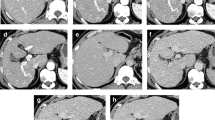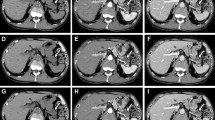Abstract
This study aims to investigate the maximum achievable dose reduction for applying a new deep learning-based reconstruction algorithm, namely the artificial intelligence iterative reconstruction (AIIR), in computed tomography (CT) for hepatic lesion detection. A total of 40 patients with 98 clinically confirmed hepatic lesions were retrospectively included. The mean volume CT dose index was 13.66 ± 1.73 mGy in routine-dose portal venous CT examinations, where the images were originally obtained with hybrid iterative reconstruction (HIR). Low-dose simulations were performed in projection domain for 40%-, 20%-, and 10%-dose levels, followed by reconstruction using both HIR and AIIR. Two radiologists were asked to detect hepatic lesion on each set of low-dose image in separate sessions. Qualitative metrics including lesion conspicuity, diagnostic confidence, and overall image quality were evaluated using a 5-point scale. The contrast-to-noise ratio (CNR) for lesion was also calculated for quantitative assessment. The lesion CNR on AIIR at reduced doses were significantly higher than that on routine-dose HIR (all p < 0.05). Lower qualitative image quality was observed as the radiation dose reduced, while there were no significant differences between 40%-dose AIIR and routine-dose HIR images. The lesion detection rate was 100%, 98% (96/98), and 73.5% (72/98) on 40%-, 20%-, and 10%-dose AIIR, respectively, whereas it was 98% (96/98), 73.5% (72/98), and 40% (39/98) on the corresponding low-dose HIR, respectively. AIIR outperformed HIR in simulated low-dose CT examinations of the liver. The use of AIIR allows up to 60% dose reduction for lesion detection while maintaining comparable image quality to routine-dose HIR.




Similar content being viewed by others
Data Availability
All the data are available upon reasonable request to the corresponding authors.
References
Volders D, Bols A, Haspeslagh M, Coenegrachts K. Model-based iterative reconstruction and adaptive statistical iterative reconstruction techniques in abdominal CT: comparison of image quality in the detection of colorectal liver metastases. Radiology. 2013;269(2):469–474. https://doi.org/10.1148/radiol.13130002
Solomon J, Marin D, Roy Choudhury K, Patel B, Samei E. Effect of Radiation Dose Reduction and Reconstruction Algorithm on Image Noise, Contrast, Resolution, and Detectability of Subtle Hypoattenuating Liver Lesions at Multidetector CT: Filtered Back Projection versus a Commercial Model-based Iterative Reconstruction Algorithm. Radiology. 2017;284(3):777–787. https://doi.org/10.1148/radiol.2017161736
Pooler BD, Lubner MG, Kim DH, et al. Prospective Evaluation of Reduced Dose Computed Tomography for the Detection of Low-Contrast Liver Lesions: Direct Comparison with Concurrent Standard Dose Imaging. Eur Radiol. 2017;27(5):2055–2066. https://doi.org/10.1007/s00330-016-4571-4
Koetzier LR, Mastrodicasa D, Szczykutowicz TP, et al. Deep Learning Image Reconstruction for CT: Technical Principles and Clinical Prospects. Radiology. 2023;306(3):e221257. https://doi.org/10.1148/radiol.221257
Singh R, Digumarthy SR, Muse VV, et al. Image Quality and Lesion Detection on Deep Learning Reconstruction and Iterative Reconstruction of Submillisievert Chest and Abdominal CT. AJR Am J Roentgenol. 2020;214(3):566–573. https://doi.org/10.2214/AJR.19.21809
Zeng L, Xu X, Zeng W, et al. Deep learning trained algorithm maintains the quality of half-dose contrast-enhanced liver computed tomography images: Comparison with hybrid iterative reconstruction: Study for the application of deep learning noise reduction technology in low dose. Eur J Radiol. 2021;135:109487. https://doi.org/10.1016/j.ejrad.2020.109487
Jensen CT, Gupta S, Saleh MM, et al. Reduced-Dose Deep Learning Reconstruction for Abdominal CT of Liver Metastases. Radiology. 2022;303(1):90–98. https://doi.org/10.1148/radiol.211838
Park S, Yoon JH, Joo I, et al. Image quality in liver CT: low-dose deep learning vs standard-dose model-based iterative reconstructions. Eur Radiol. 2022;32(5):2865–2874. https://doi.org/10.1007/s00330-021-08380-0
Vardhanabhuti V, Loader RJ, Mitchell GR, Riordan RD, Roobottom CA. Image quality assessment of standard- and low-dose chest CT using filtered back projection, adaptive statistical iterative reconstruction, and novel model-based iterative reconstruction algorithms. AJR Am J Roentgenol. 2013;200(3):545–552. https://doi.org/10.2214/AJR.12.9424
Jiang B, Li N, Shi X, et al. Deep Learning Reconstruction Shows Better Lung Nodule Detection for Ultra-Low-Dose Chest CT. Radiology. 2022;303(1):202–212. https://doi.org/10.1148/radiol.210551
Zhang G, Zhang X, Xu L, et al. Value of deep learning reconstruction at ultra-low-dose CT for evaluation of urolithiasis. Eur Radiol. 2022;32(9):5954–5963. https://doi.org/10.1007/s00330-022-08739-x
Higaki T, Nakamura Y, Zhou J, et al. Deep Learning Reconstruction at CT: Phantom Study of the Image Characteristics. Acad Radiol. 2020;27(1):82–87. https://doi.org/10.1016/j.acra.2019.09.008
Greffier J, Hamard A, Pereira F, et al. Image quality and dose reduction opportunity of deep learning image reconstruction algorithm for CT: a phantom study. Eur Radiol. 2020;30(7):3951–3959. https://doi.org/10.1007/s00330-020-06724-w
Afat S, Brockmann C, Nikoubashman O, et al. Diagnostic Accuracy of Simulated Low-Dose Perfusion CT to Detect Cerebral Perfusion Impairment after Aneurysmal Subarachnoid Hemorrhage: A Retrospective Analysis. Radiology. 2018;287(2):643–650. https://doi.org/10.1148/radiol.2017162707
Sollmann N, Mei K, Hedderich DM, et al. Multi-detector CT imaging: impact of virtual tube current reduction and sparse sampling on detection of vertebral fractures. Eur Radiol. 2019;29(7):3606–3616. https://doi.org/10.1007/s00330-019-06090-2
Kolb M, Storz C, Kim JH, et al. Effect of a novel denoising technique on image quality and diagnostic accuracy in low-dose CT in patients with suspected appendicitis. Eur J Radiol. 2019;116:198–204. https://doi.org/10.1016/j.ejrad.2019.04.026
Jensen CT, Liu X, Tamm EP, et al. Image Quality Assessment of Abdominal CT by Use of New Deep Learning Image Reconstruction: Initial Experience. AJR Am J Roentgenol. 2020;215(1):50–57. https://doi.org/10.2214/AJR.19.22332
Cao L, Liu X, Li J, et al. A study of using a deep learning image reconstruction to improve the image quality of extremely low-dose contrast-enhanced abdominal CT for patients with hepatic lesions. Br J Radiol. 2021;94(1118):20201086. https://doi.org/10.1259/bjr.20201086
Zabić S, Wang Q, Morton T, Brown KM. A low dose simulation tool for CT systems with energy integrating detectors. Med Phys. 2013;40(3):031102. https://doi.org/10.1118/1.4789628
Li W, You Y, Zhong S, et al. Image quality assessment of artificial intelligence iterative reconstruction for low dose aortic CTA: A feasibility study of 70 kVp and reduced contrast medium volume. Eur J Radiol. 2022;149:110221. https://doi.org/10.1016/j.ejrad.2022.110221
Yang L, Liu H, Han J, et al. Ultra-low-dose CT lung screening with artificial intelligence iterative reconstruction: evaluation via automatic nodule-detection software. Clin Radiol. 2023;S0009-9260(23)00031-4. https://doi.org/10.1016/j.crad.2023.01.006
Hu Y, Zheng Z, Yu H, Wang J, Yang X, Shi H. Ultra-low-dose CT reconstructed with the artificial intelligence iterative reconstruction algorithm (AIIR) in 18F-FDG total-body PET/CT examination: a preliminary study. EJNMMI Phys. 2023;10(1):1. https://doi.org/10.1186/s40658-022-00521-8
Lyu P, Liu N, Harrawood B, et al. Is it possible to use low-dose deep learning reconstruction for the detection of liver metastases on CT routinely?. Eur Radiol. 2023;33(3):1629–1640. https://doi.org/10.1007/s00330-022-09206-3
Deák Z, Grimm JM, Treitl M, et al. Filtered back projection, adaptive statistical iterative reconstruction, and a model-based iterative reconstruction in abdominal CT: an experimental clinical study. Radiology. 2013;266(1):197–206. https://doi.org/10.1148/radiol.12112707
Jensen CT, Telesmanich ME, Wagner-Bartak NA, et al. Evaluation of Abdominal Computed Tomography Image Quality Using a New Version of Vendor-Specific Model-Based Iterative Reconstruction. J Comput Assist Tomogr. 2017;41(1):67–74. https://doi.org/10.1097/RCT.0000000000000472
Nagayama Y, Nakaura T, Oda S, et al. Value of 100 kVp scan with sinogram-affirmed iterative reconstruction algorithm on a single-source CT system during whole-body CT for radiation and contrast medium dose reduction: an intra-individual feasibility study. Clin Radiol. 2018;73(2):217.e7–217.e16. https://doi.org/10.1016/j.crad.2017.09.006
Hou P, Feng X, Liu J, et al. Low Tube Voltage and Iterative Model Reconstruction in Follow-up CT Angiography After Thoracic Endovascular Aortic Repair: Ultra-low Radiation Exposure and Contrast Medium Dose. Acad Radiol. 2018;25(4):494–501. https://doi.org/10.1016/j.acra.2017.11.001
Chen Y, Liu Z, Li M, et al. Reducing both radiation and contrast doses in coronary CT angiography in lean patients on a 16-cm wide-detector CT using 70 kVp and ASiR-V algorithm, in comparison with the conventional 100-kVp protocol. Eur Radiol. 2019;29(6):3036–3043. https://doi.org/10.1007/s00330-018-5837-9
Funding
This work was supported by the National Key Research and Development Program of China (2021YFF0501504); and West China Hospital “1·3·5” Discipline of Excellence Project (ZYGD18019).
Author information
Authors and Affiliations
Contributions
Conceptualization and study design: Zhenlin Li and Guozhi Zhang; data collection: Yongchun You, Yuting Wen, Dian Guo and Wanjiang Li; statistical analysis and data interpretation: Yongchun You, Sihua Zhong, Wanjiang Li; manuscript preparation: Yongchun You, Sihua Zhong and Guozhi Zhang; all authors read and approved the final manuscript.
Corresponding authors
Ethics declarations
Ethics Approval
Institutional review board approval was obtained.
Consent to Participate
Written informed consent was waived.
Consent for Publication
The authors affirm that consent to publish has been received from all human research participants.
Competing Interests
The authors declare no competing interests.
Additional information
Publisher's Note
Springer Nature remains neutral with regard to jurisdictional claims in published maps and institutional affiliations.
Rights and permissions
Springer Nature or its licensor (e.g. a society or other partner) holds exclusive rights to this article under a publishing agreement with the author(s) or other rightsholder(s); author self-archiving of the accepted manuscript version of this article is solely governed by the terms of such publishing agreement and applicable law.
About this article
Cite this article
You, Y., Zhong, S., Zhang, G. et al. Exploring the Low-Dose Limit for Focal Hepatic Lesion Detection with a Deep Learning-Based CT Reconstruction Algorithm: A Simulation Study on Patient Images. J Digit Imaging. Inform. med. (2024). https://doi.org/10.1007/s10278-024-01080-3
Received:
Revised:
Accepted:
Published:
DOI: https://doi.org/10.1007/s10278-024-01080-3




